Slovakian Axis Forces in WWII
Initially, the Slovak Military was thought to be a capable and potentially a strong ally of the Germans. The Slovak people were considered to be strong, brave, and capable of enduring a great deal. Initial problems in the Slovak Army consisted of a general lack of modern and reliable weapons and equipment(in the wake of the German take over of the former regions of Bohemia-Moravia, basically the western region of the former Nation of Czechoslovakia), as well as problems with experienced commanders and NCOs, as Slovaks were discriminated against in the Czech Army and therefore only the native Slovakian officer corps and a small pool of Slovak NCOs existed to lead their new army. A number of Slovaks were sent to Germany to train as officers and a small German Military training mission existed in Slovakia to attempt to make up for the problems with Slovakian leadership, but the problem was never fully resolved. Slovak Axis Forces during the Campaign against Poland, 1939
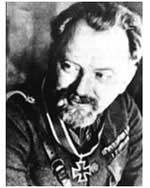 Slovakia was the only Axis-Allied Nation to take part in the campaign against Poland. With the impending German invasion of Poland slated for September of 1939, OHW requested the assistance of Slovakia. Although the Slovakian military was only six months old, it formed a small mobile combat group consisting of a number of infantry and artillery battalions. Two combat groups were created for the Campaign in Poland for use alongside the Germans. The first group was a brigade-sized formation that consisted of six infantry battalions, two artillery battalions, and a company of combat engineers, all commanded by Anton Pulanich. The second group was a mobile formation that consisted of two battalions of combined cavalry and motorcycle recon troops along with nine motorized artillery batteries, all commanded by Gustav Malar. The two groups were organized around the HQ of the 1st and 3rd Slovakian Infantry Divisions. The two combat groups saw fighting while pushing through the Nowy Sacz and Dukeilska Mountain Passes, advancing towards Debica and Tarnow in the region of southern Poland. The Slovakian Axis Expeditionary Army Group in Russia
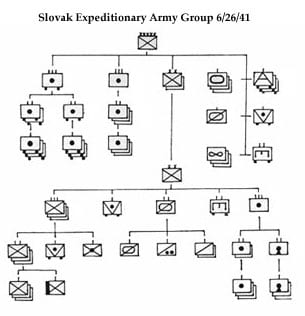 Four days after the German invasion of the Soviet Union, Slovakia sent its own units forward against the Russian lines in the form of the Slovakian Expeditionary Army Group. The Slovak Army Group was commanded by the Slovak Minister of Defense, Ferdinand Catlos. As the Campaign in the East drew on, the Slovak forces began to fall behind the massive German sweep across the Soviet Union. This was mainly because of a general lack of mobile forces able to transport the 45,000 strong Slovak Army Group alongside the German advance. Brigade PilfousekAs a result of the inability of the Slovak Army Group to keep up with the German advance, it was decided to create a mobile unit that would be capable of doing so. This was done by forming all the motorized units of the former Slovak Army Group into a single formation termed the Slovak Mobile Command, otherwise known as Brigade Pilfousek, commanded by the former commander of the 2nd Slovak Division, Rudolf Pilfousek. Brigade Pilfousek consisted of the I/6 Mot.Inf.Bn., I/11 Mot.Art.Bn., the1st Tank Bn. with the 1st and 2nd Tank Co. and the 1st and 2nd Anti-Tank Co.,2nd Recon.Bn., 1st Weapons Co., 2nd Motorcycle Co., and the I/3/I Mot.Eng.Platoon. Brigade Pilfousek advanced through Lvov and towards Vinnitsa. Around July 8th, 1941, the Brigade had advanced beyond the tactical control of the Slovak command, so control of the unit was handed over to the German 17.Armee. It was at this time that the remaining forces of the former Slovak Army Group(no longer an independent formation), were used behind the German lines in conjunction with the 103rd Rear Area Command of Army Group South in security duties and helping to eliminate pockets of Soviet resistance. By July 22nd, the Brigade, now under German control, had advanced to Vinnitsa and had pushed on towards Lipovets. The Brigade experienced heavy fighting against the Soviets during this time. Next, the Brigade moved north through Berdichev, Zhitomir, and on towards the region of Kiev. The 1st Slovak (Mobile) Infantry Division
The Slovak Fast Division was originally commanded by Gustav Malar, one of the original commanders from the Slovak advance into Poland back in 1939. By the middle of September 1941, the 1st Slovak (Mobile) Division was back in the front lines, this time near Kiev. After the fighting near Kiev ended with its final capture, the Slovak Mobile Division was transferred to the reserves of Army Group South. Here the unit moved along the Dnieper River, through Gorodishche, Kremenchug, and Magdalinowka, where heavy fighting took place. As of October 2nd, the Mobile Division was a part of the 1.Panzer-Armee fighting on the eastern side of Dnieper River near the region of Golubowka and Pereshchino. The Mobile Division was then moved on to the areas of Maripol and Taganrog, after which it spends the Winter of 1941-42 along positions on the Mius River. Later, the Mobile Division took part in the German advance into the Caucasus Region where it played a vital role in the assault and capture of the vital Soviet city of Rostov. Late in the Summer of 1942, the Divisional commander became Jozef Turanec. He led the Mobile Division across the Kuban River all the way to the region of Taupze. In late 1942, the 31st Artillery Regiment from the 2nd(Security) Infantry Division was transferred to the 1st Mobile Division. Command of the Mobile Division changed again in January 1943, when Lt.Gen Jurech took over command. 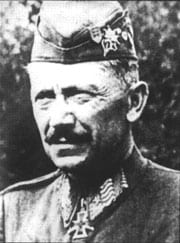 After the horrible loss at Stalingrad in the Winter of 1942/1943, the entire position of the Germans in the Caucasus region was altered, as now any further advance, the south would only ensure the complete loss of all forces south of the Mius River if and when the Soviets reached Rostov in the North, thus trapping them. As a direct result of the losses in the north, the forces in the Caucasus region were quickly pulled back north to escape possible entrapment. The 1st Slovak(Mobile) Infantry Division, as a part of the German forces fighting in the Caucasus region, was pulled back. The Mobile Division was nearly encircled and trapped near Saratowskaya, but managed to escape. The remaining portions of the Mobile Division were then airlifted out of the Kuban, but in so doing were forced to leave behind all their heavy equipment and weapons. The Mobile Division was then used to help cover the retreat of over the Sivash and Perkop land bridges. From here, the Divisions history becomes unsure for the next few weeks, as a specific record of its operations could not be located in this section. What is known though is that it later ended up being commanded once again by a new commanding officer, Elmir Lendvay. It looks as if the Division was pulled from the lines for a short while until it was again thrown into action, this time near the area of Melitopol. Soon after, the Division was caught by a massive Soviet surprise attack that had managed to break through the German lines. The Mobile Division was routed and over 2000 men were taken by the Soviets. The Mobile Division, routed and destroyed, was then pulled from the lines. 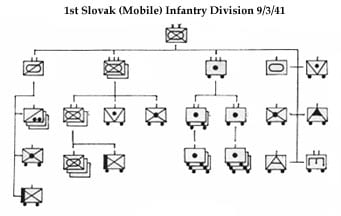 
The 2nd Slovak (Security) Infantry DivisionThe 2nd Slovak (Security) Infantry Division was used mainly in security and anti-partisan operations in the rear areas of the German lines. Originally, the Security Division was used to clean up pockets of Soviet resistance that the Germans had passed up in the advance eastwards. Later, the Slovak Security Division was used in anti-partisan operations in the region of Zhitomer. A number of the Security Divisions units were removed from its ranks and transferred to the 1st Slovak (Mobile) Infantry Division, including the 31st Artillery Regiment. After the defeat at Stalingrad, as the morale of the Slovak troops began to fall, it was moved to the area of Minsk, a much more quiet sector of the front. Soon after, on November 1st, 1943, as a result of continued problems with desertion in the unit, the Security Division was heavily disarmed and transferred to Ravenna, Italy to act as a construction brigade. The 12th Engineer BattalionAs a result of the heavy partisan actions against the German lines in 1943, the Slovak 12th Engineer Battalion was sent to the rear area of Army Group South, where it took part in vital rail repair operations to fix lines, cut by the Soviet partisans. It was later merged with the 1st Slovak (Mobile)Infantry Division when it was formed into a construction brigade in June of 1944. Alojz Esterle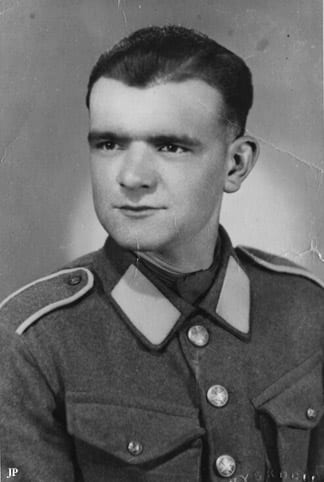 This photo is of Alojz Esterle in 1941-42. Alojz was a soldier in the Slovak Army during WWII and he fought alongside the German Wehrmacht on the Eastern Front after 1941. After serving on the Eastern Front, notably in the Caucasus region, his unit took part in the retreat west after serious reversals in 1942-43. In 1943, His unit of 2,500 – 3,000 men defected en-masse to the Soviets, officers included. He then served in the Red Army from 1943 to 1945 when WWII ended and Slovakia was “liberated” from Axis control. Alojz survived WWII and still lives in Slovakia today.
|

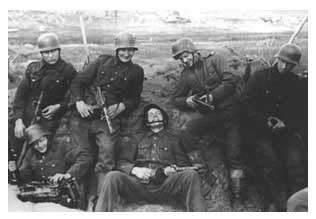 Czechoslovakia was originally formed in 1918 after the end of the First World War. The majority of the people of the new Nation of Czechoslovakia were of either Czech or Slovak heritage, the two main ethnic groups in the region for the last many years. When Czechoslovakia was formed, the basis of power and authority lay in the hands of the dominant Czechs. The Capital was chosen as Praha (Prague) which was in the traditional lands of the Czech people. Slovaks had desired autonomy from the very beginning of the formation of the Czech Nation and this desire helped prompt the formation of independent Slovakia in March of 1939. In 1939, when Germany invaded the Sudetenland, the stage was set for the eventual autonomy of the Slovak people, although their autonomy was to be guided by the will of the Germans, for they alone had allowed the Slovaks to form their pseudo-independent Nation. After the start of WWII, what began for Slovakia as a proud, enthusiastic, and eager venture, would, like so many other Axis Allied Nations, eventually lead to an attempted revolt and the disbandment of all Slovak Armed forces by the Germans into harmless construction units.
Czechoslovakia was originally formed in 1918 after the end of the First World War. The majority of the people of the new Nation of Czechoslovakia were of either Czech or Slovak heritage, the two main ethnic groups in the region for the last many years. When Czechoslovakia was formed, the basis of power and authority lay in the hands of the dominant Czechs. The Capital was chosen as Praha (Prague) which was in the traditional lands of the Czech people. Slovaks had desired autonomy from the very beginning of the formation of the Czech Nation and this desire helped prompt the formation of independent Slovakia in March of 1939. In 1939, when Germany invaded the Sudetenland, the stage was set for the eventual autonomy of the Slovak people, although their autonomy was to be guided by the will of the Germans, for they alone had allowed the Slovaks to form their pseudo-independent Nation. After the start of WWII, what began for Slovakia as a proud, enthusiastic, and eager venture, would, like so many other Axis Allied Nations, eventually lead to an attempted revolt and the disbandment of all Slovak Armed forces by the Germans into harmless construction units.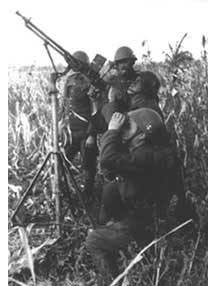 At the beginning of August 1941, the Slovak Army Group was pulled out of the lines when it was decided to form two new units that would be better suited to the actions, they would be taking part in. The best units of the former Slovak Army Group were now organized into two new divisions, the 1st Slovak(Mobile) Infantry Division and the 2nd Slovak (Security) Infantry Division. The 1st Slovak (Mobile) Infantry Division was also known as the Slovak Fast Division.
At the beginning of August 1941, the Slovak Army Group was pulled out of the lines when it was decided to form two new units that would be better suited to the actions, they would be taking part in. The best units of the former Slovak Army Group were now organized into two new divisions, the 1st Slovak(Mobile) Infantry Division and the 2nd Slovak (Security) Infantry Division. The 1st Slovak (Mobile) Infantry Division was also known as the Slovak Fast Division.